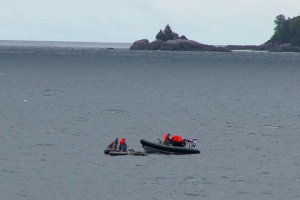Seychelles Civil Aviation Authority installs most advanced search and rescue SARIS software
General |Author: Salifa Karapetyan Edited by: Betymie Bonnelame | March 11, 2022, Friday @ 18:17| 13642 views
Savy said that with the new system search and rescue, which is now an accurate science, will be faster. (Seychelles Civil Aviation Authority)
(Seychelles News Agency) - Search and rescue at sea in Seychelles is expected to be much faster and more accurate with the introduction of new search and rescue software.
The Search and Rescue Information System (SARIS) software has been set up at the search and rescue office of the Seychelles Civil Aviation Authority (SCAA) prior to a five-day training for five Seychellois who will operate the system.
SARIS Version 4 is the latest search and rescue software developed by BMT, a global design and consulting firm based in the UK. It is considered by specialists to be the world's most advanced personal computer-based search and rescue planning system, focusing on the complex task required in search and rescue determination and coverage.
It works by calculating drift, based on data such as sea current, wind speed, and wind direction, among others, that are fed into the system.
The manager of the search and rescue office at the SCAA, Dominic Savy, said that with the new system search and rescue, which is now an accurate science, will be faster.
"The authority going out on a search and rescue will have the plan within five minutes. It is a plan that has been computed based on the international standard that we should be using. The probability of finding what you are looking for is way higher now," said Savy.
He explained that before SARIS was introduced, calculations were done manually and it could take up to three hours to come up with an area where search and rescue should be carried out.
During the training, a side meeting was held with the Meteorological Office of Seychelles to see how the necessary information could be fed straight into the system, cutting down on the time needed to input data.
Ian Smith, the software training instructor, outlined that implementing international search and rescue standards in Seychelles, an archipelago in the western Indian Ocean, raises the country's competency in the field.
"I really believe that with the world becoming more open, tourism can be affected by search and rescue. One of the biggest causes of death in the world is drowning and as tourists come here, there can be problems if search and rescue are not done properly. This is a way to keep the reputation of Seychelles as a good place to come to because an effective search and rescue unit is essential," said Smith.
For search and rescue on land, which is not covered by SARIS, Savy said that this still remains a major challenge for the country, however, one way to solve this would be the introduction and use of beacons.
"A beacon is a device smaller than a phone that can be taken along when going on hikes. Should something happen to you, you simply have to turn it on and satellites will pick up the signal. This eliminates the element of having to find someone in a search and rescue, due to the fact that we know where you are based on information provided by the satellite," said Savy.
He added that SCAA encourages people to buy and register their beacons, which can be used both on land and at sea.
Back
